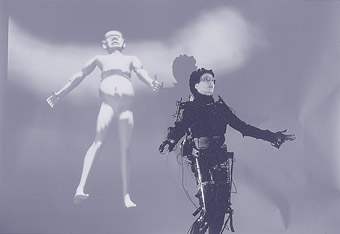The dancer captured & revealed
Peta Tait: Company in Space, CO3

Hellen Sky, Company in Space
photo Jeff Busby
Hellen Sky, Company in Space
Where do cultural fantasies about physically transplanting a human body instantly to another part of the world (read galaxy) come from if not from artistic license? State of the art instant electronic transfers that substitute digital images of the body only serve to taunt us with the inadequacies of current technology in relation to our grander imaginings. As John McCormick and Hellen Sky of Company in Space experimented with transposing the movement of Sky’s body from Melbourne to Florida, they imaginatively stretched towards the ‘what if’ of transporting her whole body. But on opening night, we were not able to witness how her body’s movement was received in Florida because the reciprocal transfer of a moving male body from there to Melbourne was not fully realised for the audience.
Company in Space’s performance work may well stir the spatial imagination of viewers. While it is at the mercy of the law of technology—we desire what it has yet to deliver—CO3 as an event was composed of multiple performances by bodies on the sidelines. Sky, in a motion capture suit, moved in slow motion along a balcony at the Capitol Theatre, across to its aisles and down to the stage. She moved under the weight of the leather suit with its metal rod structure outlining her limbs like a second skeleton, one worn outside the muscular frame. She carried the added weight of familiar images of space suits moving on the moon or divers on the ocean floor. I enjoyed the metaphoric resonance of a healthy body at large, hooked up to monitors capturing its every twitch, its every breath, and watched intensely by attendants—another visible performance.
Sky’s body in motion radiated with the aesthetic beauty of exposed machinery; from the delicate brass of an old clock mechanism at Greenwich to a new look Apple iMac. Competing for attention with her live body, however, was her live movement doubled into animated screen imagery.
On the screen were animated figures moving in unfamiliar trajectories. Sky was controlling them from her motion capture suit without any visible delay. As she moved her arms, personified figures moved theirs in animated landscapes; firstly, an old woman outside a house as it began to snow; secondly, a young woman in an earth-bound landscape with artificial trees. A bodiless coat joined this screen woman followed by 2 upside-down legs. The background began to erode into darkness and the virtual world turned into an arcade with a robotic figure and then into shadows. Once the simulation of humanness vanished and figures became geometric in constant motion, patterns swirled like digital diagrams of a body’s movement. The most sublime was a paper-like image in an electronic wind.
There was sound, but on reflection it may have been supplementary if not incidental, sometimes like flowing water, mostly an electronic hum. McCormick and the production team worked in reaction to Sky’s bodily movements as she drove the visual effects. Why was I drawn to watch Sky more than the screen most of the time? Even a completely covered live body in slow motion was more appealing to this perceptual body-self. Paradoxically, the dancer’s physical body was hidden to make its muscular movement visible on the screen.
Company in Space, CO3, concept John McCormick developed in collaboration with Miriam English, Hellen Sky, Keith Robertson. RMIT Capitol Theatre, Melbourne, Sept 6
RealTime issue #46 Dec-Jan 2001 pg. 27






